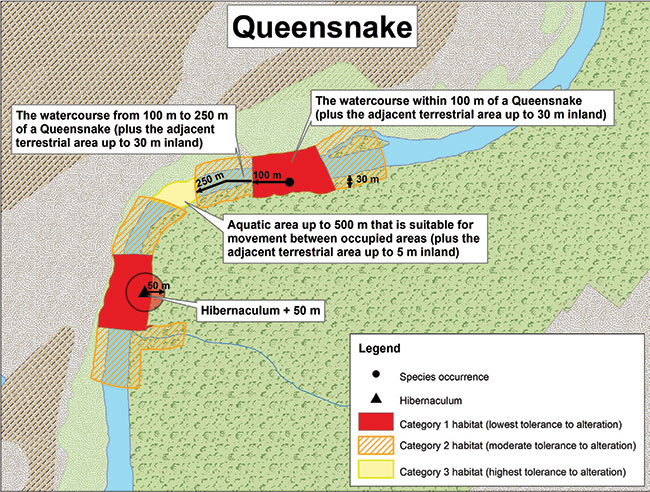Queensnake Habitat Protection Summary
This document provides a brief description of the area that is protected as habitat for the Queensnake through a habitat regulation under the Endangered Species Act.
The Queensnake is a slender, moderately sized, semi-aquatic snake. Queensnakes are typically found in rock or gravel bottomed streams or rivers where they feed almost exclusively on crayfish. The species was assessed by the Committee on the Status of Species at Risk in Ontario (COSSARO) and listed as endangered on September 28, 2010. More information about the species' status can be found at: Queensnake.
The habitat regulation for Queensnake protects:
- the area within 50 metres of all natural or man-made Queensnake hibernacula;
- any part of a watercourse, waterbody or marsh up to the high water mark that is continuous and within 250 metres of the area being used by a Queensnake;
- the area up to 30 metres inland from the high water mark adjacent to the occupied watercourse, waterbody or marsh;
- where two known populations occur within one kilometre of each other, the intervening aquatic area and five metres inland from the high water mark is protected to allow for movement and to maintain connectivity between populations;
- these aquatic features and riparian areas are protected until five consecutive years of documented non-use.
The regulation applies in the Regional Municipality of Waterloo, the Municipality of Chatham-Kent, the cities of Brantford, London and Windsor, the counties of Brant, Bruce, Essex, Huron, Lambton, Middlesex and Oxford, Haldimand County and Norfolk County.
Supporting rationale:
- Regulating 250 metres around observations is a cautionary approach that ensures all Queensnake seasonal movement areas are protected.
- The area within 30 metres of the high water mark incorporates all features that the species depends on for hibernation, gestation, birthing, shedding and thermoregulation as well as areas for movement between sites.
- Protecting a movement corridor between clusters of observations allows for gene flow and connectivity between sites.
- A five-year term allows sufficient time to determine that the site is no longer being used.
Activities in Queensnake habitat:
Activities in regulated habitat can continue as long as the function of these areas is maintained and individuals of the species are not killed, harmed, or harassed.
Generally compatible:
- Yard work such as maintenance of existing lawns and gardens.
- Renovations of small structures such as a shed or a deck.
- Pruning of shrubs or trees away from the water’s edge.
- Use of existing, sanctioned recreational trails.
Generally not compatible
- Significant reduction or clearing of natural features, such as forests and wetlands.
- Replacement of natural shoreline with erosion control structures such as gabion baskets, concrete walls or rip-rap.
- Alteration of aquatic habitat or adjacent lands which result in substantial impacts to water quality, flow or levels.
- Removal of shoreline vegetation at the water’s edge.
Key terms:
- Hibernaculum: An underground feature, natural or man-made, that extends below the frost line where snakes hibernate to avoid extreme cold temperatures during the winter. Some examples are bedrock fissures, small mammal burrows and building foundations.
Below you will find an example diagram of how this regulation would be applied to protect habitat for this species. It indicates how the protected habitat has been categorized, based on how the species uses the habitat and how much activity or change can occur within the habitat, as per the policy "Categorizing and Protecting Habitat Under the Endangered Species Act". This policy can be found at: Queensnake.
Sample application of the habitat regulation:

Enlarge Sample application of the habitat regulation
The content of this summary is provided for convenience only. For accurate reference and the most recent version of the regulation, please view Ontario Regulation 832/21 on e-Laws
Footnotes
- footnote[*] Back to paragraph If you are considering an activity that may not be compatible with regulated habitat, please contact your local MNR office for more information and/or to discuss ESA authorization options.